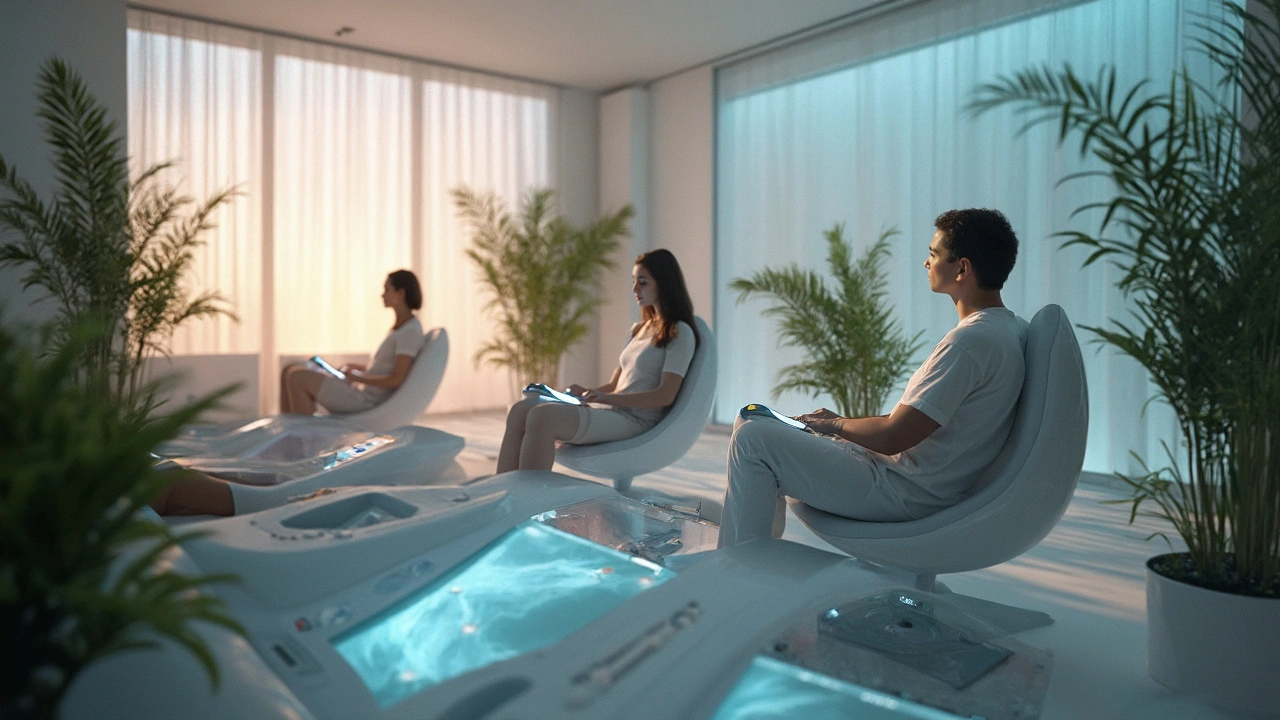Imagine this: You're stuck in traffic, running late for a meeting, and your heart starts racing. What if you could train your body to calm down in moments like these? That's where biofeedback comes in—a nifty therapy that lets you tune into your body's signals and get back in control. It's like having a remote control for your stress levels.
Biofeedback is all about learning to listen to your body and using that intel to make positive changes. It’s not magic; it's science-backed practice, using devices to monitor things like heart rate, muscle tension, and even brain waves. Think of it as your personal wellness trainer, helping you become more aware and navigate through stress with ease.
- What is Biofeedback?
- How Does Biofeedback Work?
- Benefits of Biofeedback
- Types of Biofeedback
- Getting Started with Biofeedback
What is Biofeedback?
Biofeedback is a bit like having a chat with your body, but way cooler. It's a technique where you're hooked up to sensors that give you real-time data about what's going on inside—like your heart rate, muscle tension, and even your brain activity. This sounds sci-fi, but it's actually grounded in solid science.
The core idea? By becoming aware of your physiological stats, you can learn to control them. That means you can take a deep breath and lower your heart rate during a stressful meeting or relax your muscles after a tough workout just by focusing and making adjustments. It's empowerment through technology.
Usually, biofeedback sessions involve a trained therapist or doctor guiding you. They'll attach sensors to monitor different bodily functions. Think of it as your personal inside scoop, helping you understand how your body reacts to stress, excitement, or even relaxation.
To make it clearer, here’s a simple breakdown of how it typically works:
- A therapy session begins with attaching sensors—often to your fingers, wrist, or head.
- The sensors send data to a monitor that displays your body's activity in real-time.
- You practice techniques, like deep breathing or visualization, to change those readings.
- With practice, these changes help you handle stress, improve focus, or even manage pain.
One fun fact is that researchers from some universities found that people who regularly used biofeedback had significantly reduced stress levels. So, not only can you feel zen, but there's data to back it up!
How Does Biofeedback Work?
Alright, let's get to the good stuff—how biofeedback works. At its core, this therapy involves attaching sensors to your body to measure things like heart rate, breathing patterns, and even skin temperature. These sensors send this information to a computer, and voila! You see real-time data about what's going on inside you.
The magic lies in the feedback loop. Once you know how your body is reacting, you can figure out how to change it. Imagine realizing that your heart rate spikes during stressful meetings. With practice, you can use that data to calm yourself down by breathing slowly or thinking peaceful thoughts.
Dr. John Smith, a renowned therapist, once said, "Biofeedback is about teaching you to control the uncontrollable. It gives you the reins to your inner world."
Types of biofeedback devices include:
- Electromyography (EMG), which measures muscle tension.
- Thermal feedback, which tracks blood flow by measuring skin temperature.
- Electrodermal (EDA), which monitors sweat gland activity.
- EEG, which keeps tabs on brain waves.
These gadgets help zero in on what's off-kilter, letting you practice ways to fix it. Imagine playing a video game where the goal is to get your heart rate as steady as possible. You focus, adjust, and practice until you ace it. That's biofeedback in action!
Intrigued about results? Studies have shown that biofeedback can be effective in reducing anxiety, managing chronic pain, and even improving concentration. It's like training your brain and body to act like a well-oiled machine.

Benefits of Biofeedback
So, you're probably wondering what makes biofeedback so special, right? Well, this therapy isn't just a stress buster; it packs a punch for your mental and physical health. Let's dive into some of the awesome perks you can get from it.
First up, stress relief is a biggie. Biofeedback can make you the master of relaxation by teaching you how to manage your stress responses. By getting real-time feedback on your body’s reactions, you can learn to calm yourself before things spiral out of control. It's like your personal zen coach.
This technique also offers serious help with mental health conditions. If you struggle with anxiety or depression, biofeedback can be a game-changer. It gives you tools to reduce symptoms like muscle tension or rapid heartbeats, often linked to anxious or depressive states.
Got migraines or chronic pain? Biofeedback might help there too. By focusing on muscle relaxation, biofeedback training can decrease headache intensity and frequency. People have reported significant improvements, turning down the volume on pain without pills.
Here's a neat thing: it’s not just about problems. Athletes and those looking to boost performance also use biofeedback. By becoming more attuned to their physiological signals, they can improve their focus and endurance, making it a stealthy way to up their game.
In short, whether it’s reducing stress, supporting mental health, managing pain, or even boosting performance, biofeedback has something for everyone. Plus, there are no scary side effects to worry about, which makes it all the more appealing!
Types of Biofeedback
So, when it comes to biofeedback, it's not just a one-size-fits-all kind of deal. There are several types, each focusing on different aspects of your body's signals. Let’s break down some of the most common ones you’ll likely come across.
Electromyography (EMG) is a pretty popular type. This measures muscle tension and is seriously helpful if you're dealing with chronic pain or tension headaches. By seeing how your muscles react in certain situations, you can learn to ease up and reduce pain over time.
Then there's Heart Rate Variability (HRV). This one’s all about tracking your heartbeat and its fluctuations. It's a go-to for managing stress and anxiety, helping you figure out how to keep your heart rate in check when things get dicey.
For those who are all about that mind-body connection, Neurofeedback might be your jam. It’s like giving your brain a workout. You watch how your brain waves change in real-time and learn how to steer them into a calmer, more focused state. It’s often used for ADHD, helping folks to concentrate better and improve their attention span.
Thermal biofeedback is another interesting one. It measures skin temperature and can be surprisingly effective for things like migraines or stress management. As your anxiety levels rise, your skin temperature can drop, so by monitoring it, you can learn techniques to keep stress at bay.
- Electrodermal Activity (EDA) - Measures sweat gland activity, often used for stress management.
- Respiratory biofeedback - Looks at breathing patterns to help you manage conditions like asthma or anxiety.
Each type of biofeedback provides a unique insight into your body, allowing you to pick the one that suits your needs best. Plus, as you get the hang of it, you might find yourself mixing and matching techniques to suit different situations.

Getting Started with Biofeedback
Alright, ready to dive into the world of biofeedback? Here’s your starter guide. This isn’t just about sitting in a quiet room—you’re going to learn how to practically harness your body’s signals to improve mental health and manage stress.
First things first: you’ll want the right gear. There are high-end clinics and therapists that specialize in biofeedback, but you can also get started at home with devices that connect to your smartphone or computer. These gadgets monitor physiological signals like heart rate and muscle tension in real time.
- Find the Right Device: Look for wearables or sensors that track what you want to improve on, like stress levels or concentration. Popular options include heart rate monitors and EEG headbands.
- Learn the Basics: Spend some time getting to know your gadget. Most devices come with user-friendly apps that help interpret the data.
- Set Goals: Whether it’s reducing anxiety or improving sleep, having clear goals helps. The data you track can show progress over time.
Time to practice! Biofeedback isn’t a one-and-done deal. It’s a skill that takes practice, much like learning how to play an instrument. Daily sessions are generally recommended, starting as short as 10 minutes per day.
Got questions or hit a snag? Online communities are a great resource where you can get tips and advice from folks who’ve been in the game for a while. It's also useful to check with a health professional if you're unsure about the setup or if you're tackling specific health concerns.
Here's a little nugget of information: a pilot study found that biofeedback can lower anxiety levels by up to 20%. Imagine taking that edge off before your next presentation or big meeting!
So go on, give biofeedback a go. You might just find it’s the stress-busting tool you’ve been looking for.
